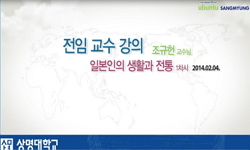야나기타 구니오(柳田国男, 1875~1962)는 일본민속학의 창시자이며 일본 근대학문 형성에 지대한 영향력을 끼친 인물이다. 일찍이 농무성 관료로서 농정학에서 시작하여 민속학으로 옮겨가면...
http://chineseinput.net/에서 pinyin(병음)방식으로 중국어를 변환할 수 있습니다.
변환된 중국어를 복사하여 사용하시면 됩니다.
- 中文 을 입력하시려면 zhongwen을 입력하시고 space를누르시면됩니다.
- 北京 을 입력하시려면 beijing을 입력하시고 space를 누르시면 됩니다.

야나기타(柳田國男) 민속학의 중심이동과 ‘경세제민(経世済民)’ 학 = The Central Movement of Kunio Yanagida’s Folklore and the Idea of Governing a Nation and Providing Relief to People(経世済民) - from the Comparative Point of View with the Administration Theory of Sorai Ogyu
한글로보기https://www.riss.kr/link?id=A101825808
- 저자
- 발행기관
- 학술지명
- 권호사항
-
발행연도
2016
-
작성언어
Korean
- 주제어
-
등재정보
KCI등재
-
자료형태
학술저널
- 발행기관 URL
-
수록면
107-137(31쪽)
- 제공처
-
0
상세조회 -
0
다운로드
부가정보
국문 초록 (Abstract)
야나기타 구니오(柳田国男, 1875~1962)는 일본민속학의 창시자이며 일본 근대학문 형성에 지대한 영향력을 끼친 인물이다. 일찍이 농무성 관료로서 농정학에서 시작하여 민속학으로 옮겨가면서 학문적 대상이 크게 변화하였다. 즉 그의 초기연구는 산인, 유랑민, 예능민에 대한 관심에서 출발하였지만 후기로 오면 연구대상에서 거의 제외된다. 그 대신 평지인, 토착민, 도작민으로 옮겨가 상민이라는 새로운 개념을 제시하게 이른다. 학문대상에 대한 중심이동은 ‘세상을 위해 사람을 위해(世のため人のため)라는 그의 실천적 학문태도와 무관하지 않다. 다시 말해서 경세제민의 民은 일반 농민이자 도작민이며, 평지인이자 정착민이었다. 경세제민 사상은 기본적인 유교 이념으로 특별하다고 할 수 없지만, 주목할 점은 야나기타의 학문적 지향방향이 에도시대 유학자 오규 소라이(荻生徂徠, 1666~1728)의 정책적 의견에 매우 근접해 있다는 점이다. 본고는 에도막부에 제안한 소라이의 정책의견서 『정담(政談)』에 나타난 경세론 즉, 농민과 무사 중심의 토지정착론이 야나기타의 상민론에 어떻게 이어지는지에 대해서 살펴보았다. 시대적 상황의 한계를 인정하더라도 소라이는 토지정착론을 통치의 근본이라고 주장한다. 토지정착론의 대상은 농민과 당시의 사회적 지배계층이었던 무사들이었다. 특히 농민의 토지정착 방책으로 여행자유 및 거주이전의 제한 등은 통치자의 입장을 대변한 논리이기는 하지만, 밀접한 협동사회의 구축과 함께 마을 구성원간의 친밀감은 악행을 방지하고 풍속을 순화시킨다고 보았다. 따라서 당시 농업에서 이탈한 농민이나 떠돌이 무사(낭인)들은 고향으로 돌아가서 정착해야 하는 이유를 다양한 각도에서 제시하고 있다. 반면 상인의 증가는 사회통제를 어렵게 하며 불안의 근원이 된다고 보았다. 이러한 소라이의 토지정착론은 야나기타가 농정학에서 산업조합의 구성과 민속학에서의 정착민 즉 농민에 중점을 둔 상민론과 밀접한 접점을 이루고 있음을 검토하였다.
일본 민속학의 성립초기, 야나기타학이 농정학에서 민속학으로 이행하면서 학문의 대상이 크게 변한 것은 민속학을 독립적인 학문으로서 그 위상을 세우기 위한 고심의 결과물이기도 했지만, 무엇보다도 상민에 의한 상민을 위한 학문이 되기를 바랐던 것이다. 시대적 상황과 배경을 달리하지만 두 학자의 학문적 바탕은 경세제민의 사상에서 출발하고 있음을 확인할 수 있다.
다국어 초록 (Multilingual Abstract)
Kunio Yanagida(柳田国男, 1875~1962) is the founder of Japanese folklore who exerted a great influence on the formation of Japan’s modern learning. He changed his direction from agricultural adminstration policy study to the folklore, which chang...
Kunio Yanagida(柳田国男, 1875~1962) is the founder of Japanese folklore who exerted a great influence on the formation of Japan’s modern learning. He changed his direction from agricultural adminstration policy study to the folklore, which changed his academic subject accordingly. Initially, his major subject was a mountain dwellers, wanderers, and entertainers while they were replaced by plain dwellers, native people and farmers in the later period. The change of his academic subjects is closely related with his new concept of common people(常民) which reflects his practical attitude that emphasizes the idea of governing a nation and providing relief to people(経世済民).
This idea is not so special as it was basically a Confucian idea. What attracts our concern is that it seems to be linked closely with the policy theory of Sorai Ogyu(荻生徂徠, 1666~1728), a great scholar of Confucianism in the Edo era. The settlement guidance theory of farmer and samurai class in Sorai’s Seidan(政談; discussion of policy) that displays a similar view-point as Yanagita’s concept of the common people. So this paper trace the possible relationship of both ideas.
Sorai insists on a settlement guidance theory as the base of governing a nation. The object of his theory was focused on samurai and farmer class as it would build up cooperative cummunity, improve the social unity of villagers, and thereby purify manners and customs by reducing misdeeds even though it restricted their freedom of residence move and travelling. He proposed the merits of his idea in many points. Meanwhile, he warns that the increase of merchants and traders would cause social unrest difficult to control. In many points, Sorai’s settlement guidance theory assumes a close resemblance with Yanagita’s common people theory based on the constitution of industrial guild in agricultural administration.
The early phase of Japanese folklore was led by Yanagida who broke new field of folklore escaping from agricultural administration study with his common people theory while founding its firm base as an independent science. In conclusion, it seems obvious that both scholars’ ideas start from the thought of governing a nation and providing relief to people in spite of time gap.
목차 (Table of Contents)
- 국문초록
- 1. 들어가기
- 2. 야나기타의 경세제민의 학(‘世のため人のため’)
- 3. 야나기타학의 중심이동
- 4. 소라이의 경세론: 토지정착론의 전개
- 국문초록
- 1. 들어가기
- 2. 야나기타의 경세제민의 학(‘世のため人のため’)
- 3. 야나기타학의 중심이동
- 4. 소라이의 경세론: 토지정착론의 전개
- 5. 야나기타와 소라이의 교차점
- 6. 나오기
- 참고문헌
동일학술지(권/호) 다른 논문
-
동제문화의 지역적 변화와 이면적 지속성의 변증법적 인식
- 실천민속학회
- 임재해(Lim, Jae-Hae)
- 2016
- KCI등재
-
- 실천민속학회
- 박흥주(Park, Heung-Ju)
- 2016
- KCI등재
-
최치원의 신격화와 홍성 월계리 용연 마을 공동 제의의 전승 양상
- 실천민속학회
- 허용호(Heo, Yong-Ho)
- 2016
- KCI등재
-
- 실천민속학회
- 홍태한(Hong, Tea-Han)
- 2016
- KCI등재





 DBpia
DBpia


